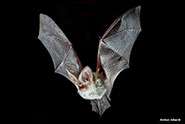Grey long-eared bat, Plecotus austriacus, in flight. Credit: Antton Alberdi
Millions of pounds are being spent to protect bats from disturbance by building development and renovations, however a lack of follow-up monitoring makes it difficult to tell whether conservation efforts are effective.
Researchers from the University of Bristol Mammal Research Unit found that between 2003 and 2005 an estimated £4.3 million was spent by developers in England to provide new homes for displaced bats, but less than 20 per cent of sites were monitored afterwards for their impact on bat populations.
Dr Emma Stone, lead author of the study, said: "Despite the licensing process and the millions spent on it each year, we are still unable to assess the impacts of the mitigation and development on bat populations."
All UK bat species are endangered and are protected by the European Union Habitats Directive. It is illegal to damage a bat roost or disturb, capture or injure a bat. However developers who wish to modify a building containing bats can apply to Natural England for a license that permits necessary disturbance, providing that they take measures to maintain the local bat population.
The license holder must provide new roosting areas for bats displaced by building developments, such as bat boxes and bat lofts. These are assumed to be 100 per cent successful by Natural England. However the study showed that this could be overly optimistic because only 74 per cent of bat lofts were found to contain bats in the areas monitored post-development. New bat roosts were on average half the size of the original roost spaces, a direct contradiction to Natural England's recommendation to "maintain roost size as close to the original as possible". Bats may not be able to use these smaller spaces, but conservationists cannot look for any potential links because of a lack of follow-up information.
Dr Stone said: "The current derogation licensing system is neither cost effective nor fit for purpose, and needs to be overhauled to make it evidence-based and quantifiable."
Since 2010, the licensing process was changed so that developers have to include post-development monitoring of the effects of mitigation measures such as bat boxes on the local bat population. This would provide more information about the impacts of development on bats, however Dr Stone believes more needs to be done to evaluate the information obtained. "Overall there are still huge improvements required, including a shift in approach from form-filling to an evidence-based approach," she said.
More information: Stone, E. L., Jones, G., Harris, S. (2013), "Mitigating the Effect of Development on Bats in England with Derogation Licensing." Conservation Biology, 27: 1324–1334. doi: 10.1111/cobi.12154
Journal information: Development , Conservation Biology
Provided by University of Bristol






















